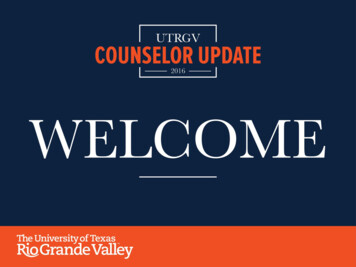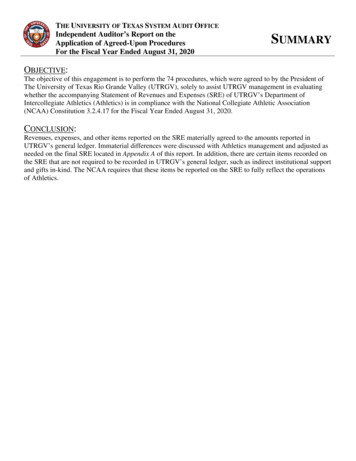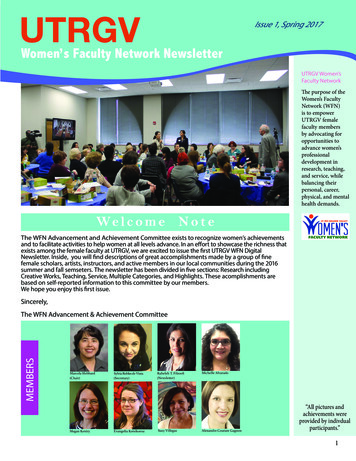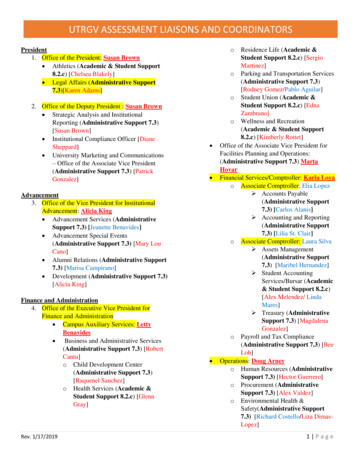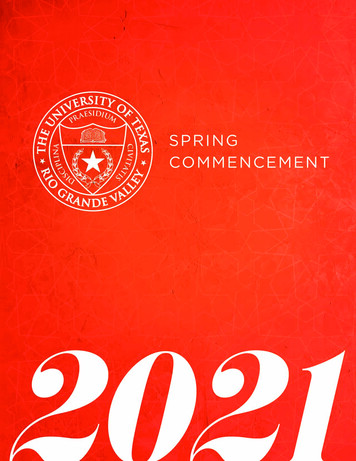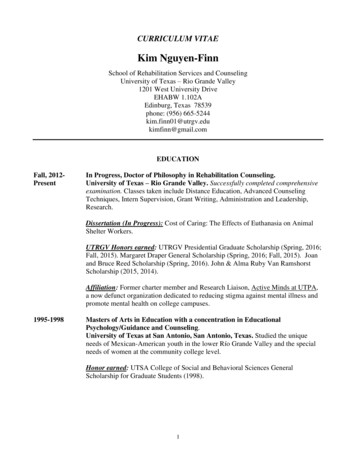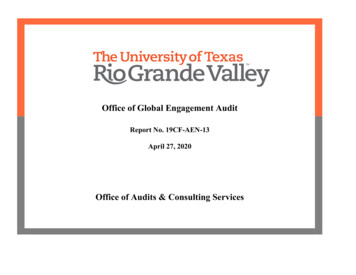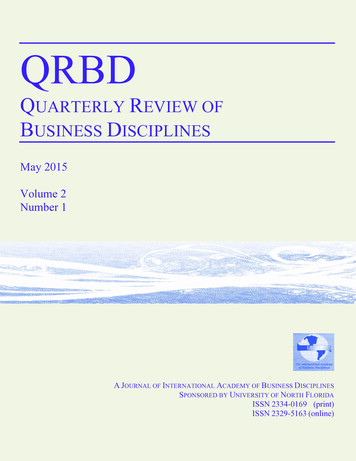
Transcription
QRBDQUARTERLY REVIEW OFBUSINESS DISCIPLINESFebruaryMay20152015Volume 21Number 14A JOURNALOURNAL OFOF IINTERNATIONALNTERNATIONAL AACADEMYCADEMY OFOF NSORED BYBY SNISSN2334-01692334-0169 9-5163
Blank inside front cover
QRBD - QUARTERLY REVIEW OF BUSINESS DISCIPLINESA JOURNAL OF INTERNATIONAL ACADEMY OF BUSINESS DISCIPLINESFROM THE EDITORSThis issue of Quarterly Review of Business Disciplines begins with apaper written by co-authors Diane Bandow, Joseph Gerweck, and TerrySelf, which won the Best Paper Award at the 2015 International Academyof Business Disciplines Conference in Orlando, Florida. Olga Lazitski, adoctoral student, who is currently working on her dissertation, alsopresented her paper in Orlando in order to get feedback from scholars thatshe could incorporate into her body of research to make it stronger.Ronald Taylor, Michael Coolsen, and Cailey Aubrey’s paper presents aportrayal of U.S. & U.K Women’s Roles in Advertising. Kelley Jones’research provides insight into attitudes toward women managers in maleand female-dominated cultures and explores the dynamics from a femaleperspective.Liqiong Deng’s research on the effects of regulatory focus on InformationTechnology substitution highlights why some people are so hesitant toupgrade while others are more than willing to commit to the newest trendsin technology. The issue concludes with the research of Aimee Sheltonand Xenja Lindberg, which explains the necessity for service learning andoffers solutions to implement it into academic programs.We hope you enjoy reading the papers in this issue as much as we did.Margaret A. Goralski, Quinnipiac University, Editor-in ChiefKaye McKinzie, University of Central Arkansas, Associate Editor
QRBD - QUARTERLY REVIEW OF BUSINESS DISCIPLINESA JOURNAL OF INTERNATIONAL ACADEMY OF BUSINESS DISCIPLINESThe Quarterly Review of Business Disciplines (QRBD) is published by the International Academy ofBusiness Disciplines quarterly in February, May, August, and November.Manuscript Guidelines/Comments. QRBD is a blind peer-reviewed journal that provides publication ofarticles in all areas of business and the social sciences that affect business. The Journal welcomes thesubmission of manuscripts that meet the general criteria of significance and business excellence.Manuscripts should address real-world phenomena that highlight research that is interesting and different– innovative papers that begin or continue a line of inquiry that integrate across disciplines, as well as,those that are disciplinary. The Journal is interested in papers that are constructive in nature and suggesthow established theories or understandings of issues in business can be positively revised, adapted, orextended through new perspectives and insights. Manuscripts that do not make a theoretical contributionto business studies or that have no relevance to the domain of business should not be sent to QRBD.Submissions to QRBD must follow the journal’s Style Guide for Authors, including length, formatting,and references. Poorly structured or written papers will be returned to the authors promptly. Manuscriptlength is approximately 16–20 single-spaced pages. Acceptance rate is 25-28%.Description. The Quarterly Review of Business Disciplines is a quarterly publication of the InternationalAcademy of Business Disciplines (IABD); a worldwide, non-profit organization established to foster andpromote education in all of the functional and support disciplines of business. The objectives of QRBDand IABD are to stimulate learning and understanding and to exchange information, ideas, and researchstudies from around the world. The Academy provides a unique global forum for professionals andfaculty in business, communications, and other social science fields to discuss and publish papers ofcommon interest that overlap career, political, and national boundaries. QRBD and IABD create anenvironment to advance learning, teaching, and research, and the practice of all functional areas ofbusiness. Quarterly Review of Business Disciplines is published to promote cutting edge research in all ofthe functional areas of business.Submission Procedure. An electronic version of the manuscript must be submitted in MS Word to theEditor-in-Chief, Dr. Margaret A. Goralski at Margaret.Goralski@quinnipiac.edu. Upon completion of areview by expert scholars who serve on the QRBD Editorial Review Board, the first author will beinformed of acceptance or rejection of the paper within a one to two month timeframe from thesubmission date. If the paper is accepted, the first author will receive a formal letter of acceptance alongwith the QRBD Style Guide for Authors. IABD members and authors who participate in the IABD annualconference are given first priority as a matter of courtesy. For additional information, please visitwww.iabd.org.Subscription. The annual subscription price for QRBD is US 100 plus postage and handling. Single issueprice is 35 per issue plus postage and handling.The data and opinions appearing in the articles herein are the responsibility of the contributing authors.Accordingly, the International Academy of Business Disciplines, the Publisher, and Editor-in-Chief accept noliability whatsoever for the consequences of inaccurate or misleading data, opinions, or statements.
QRBD - QUARTERLY REVIEW OF BUSINESS DISCIPLINESA JOURNAL OF INTERNATIONAL ACADEMY OF BUSINESS DISCIPLINESEDITOR-IN-CHIEFASSOCIATE EDITORMargaret A. Goralski, Quinnipiac UniversityEmail: Margaret.Goralski@Quinnipiac.eduKaye McKinzie, University of Central ArkansasEmail: KMcKinzie@uca.eduEDITORIAL REVIEW BOARDFelix Abeson, Coppin State Universityfabeson@coppin.eduMichael Baechle, Baden Wuerttemberg CooperativeState University baechle@dhbw-ravensburg.deRaquel Casino, Turkeyraquelcasino@hotmail.comJohn Fisher, Utah Valley UniversityJohn.Fisher@uvu.eduAmiso M. George, Texas Christian Universitya.george2@howard.eduSaurabh Gupta, University of North Floridas.gupta@unf.eduKayong Holston, Ottawa UniversityKayong.holston@ottawa.eduZahid Y. Khairullah, St. Bonaventure Universityzyk@sbu.eduArthur Kolb, University of Applied Sciences – KemptenGermany, Arthur.Kolb@fh-kempten.deHarold W. Lucius, Rowan Universityluciush@rowan.eduChynette Nealy, University of Houston – Downtownnealyc@uhd.eduRodney A. Oglesby, Drury Universityroglesby@drury.eduCrystal L. Owen, University of North Floridacowen@unf.eduJ. Gregory Payne, Emerson Collegezulene@aol.comShakil Rahman, Frostburg State Universitysrahman@frostburg.eduGregory Robbins, Southern CT State UniversityRobbinsg2@southernct.eduZiad Swaidan, University of Houston, Victoriazswaidan@gmail.comPaloma Bernal Turnes, Universidad Rey Juan Carlos,Spain, Paloma.bernal@urjc.esNathan K. Austin, Morgan State UniversityNathan.Austin@morgan.eduMohammad Z. Bsat, National Universitymdbsat@yahoo.comKaushik Chaudhuri, Shiv Nadar University, Indiakaushik.chaudhuri@snu.edu.inPhillip Fuller, Jackson State UniversityPhillip.r.fuller@isums.eduDominik Guess, University of North Floridadguess@unf.eduTalha D. Harcar, Penn State, BeaverTdh13@psu.eduKellye Jones, Clark Atlanta Universitykjones@cau.eduJohn Mark King, East Tennessee State Universityjohnking@etsu.eduBrian V. Larson, Widener Universitybvlarson@widener.eduMarty Mattare, Frostburg State Universitymmattare@frostburg.eduBonita Dostal Neff, Valparaiso Universitybonita.neff@valpo.eduEnric Ordeix-Rigo, Ramon Llull University, Spain,enricor@blanquerna.url.eduPhilemon Oyewole, Howard Universitypoyewole@howard.eduJean-Michel Quentier, France Business School, jeanmichel.quentier@france-bs.comKarin Reinhard, Baden Wuerttemberg Cooperative StateUniversity, Reinhard@dhbw-ravensburg.deDale Steinreich, Drury Universitydsteinreich@drury.eduJohn C. Tedesco, Virginia Tech UniversityTedesco@vt.eduChulguen (Charlie) Yang, Southern CT State University,YangC1@SouthernCT.edu
INTERNATIONAL ACADEMY OF BUSINESS DISCIPLINESMISSION STATEMENTThe organization designated as the International Academy of Business Disciplinesis a worldwide, non-profit organization, established to foster and promote educationin all of the functional and support disciplines of business.WWW.IABD.ORGThe Quarterly Review of Business Disciplines (QRBD) is listed inCabell’s Directory of Publishing Opportunities.
QRBD - QUARTERLY REVIEW OF BUSINESS DISCIPLINESA JOURNAL OF INTERNATIONAL ACADEMY OF BUSINESS DISCIPLINESVOLUME 2 NUMBER 1 MAY 2015ISSN 2329-5163 (online)ISSN 2334-0169 (print)CONTENTSARTICLESSupporting & Empowering Knowledge Workers & Communities of PracticeDiane Bandow, Joseph Gerweck, Terry B. SelfSearching for Antagonistic Counterpart of Manipulation: Does GenuineCommunication Exist?Olga Lazitski119The Portrayal of U.S. & U.K. Women’s Roles in Advertising: Testing the MirrorRonald K. Taylor, Michael Coolsen, Cailey Aubrey31Women Managing in Male & Female Dominated CulturesKellye Jones39The Effects of Regulatory Focus on IT SubstitutionLiqiong Deng53Implementing Service Learning Into Academic ProgramsAimee Shelton, Xenja Lindberg71Copyright @ 2015 International Academy of Business DisciplinesPapers in this journal are posted online ahead of the print issue on theInternational Academy of Business Disciplines website (www.iabd.org)
This page has been intentionally left blank.
Quarterly Review of Business Disciplines – Volume 2, Issue 1, May 2015SUPPORTING AND EMPOWERING KNOWLEDGE WORKERSAND COMMUNITIES OF PRACTICEDiane Bandow, Troy Universitybandow2@troy.eduJoseph Gerweck, Manager, Project Controls, DTEgerweckjt@dteenergy.comTerry B. Self, MSHRM, Independent Researcherterrybself@gmail.comABSTRACTMuch has been written about the potential for knowledge workers and communities of practice(CoPs). The potential for innovation, creativity, and knowledge sharing is intriguing and showspromise. The appropriate work environment and organizational culture are necessary to supportknowledge workers and the promise of CoPs; this may be a change for some from the existingwork environment and expectations, which are structured under more traditional managementapproaches. A review of organizational culture and the roles of technology and social mediadescribe some of the challenges organizations must address. The alignment with knowledgemanagement efforts and CoPs is discussed in terms of tacit and explicit knowledge. Socialnetworks contribute to learning, creativity, and innovation. CoPs should identify technologyneeded to support work activities, which then can be enabled by management. Reviewingpractices relative to employee empowerment and participation are necessary as well asacknowledgment that knowledge workers and their CoPs, not management, are responsible forsharing knowledge and improving their performance in the organization. As CoPs and theirmembers can become significant capital assets, competitive advantage may be at risk withoutnecessary support.Keywords: communities of practice (CoPs), knowledge management (KM), tacit knowledge,explicit knowledge, knowledge sharingINTRODUCTIONOrganizations must satisfy both shareholders or owners and the human capital that gives theorganization power – knowledge workers (Drucker, 1999). As Drucker noted, competitiveadvantage will determine organizational survival; he proposed the need to attract and keepknowledge workers as a fundamental requirement. This means organizations must activelypursue human capital to better serve stakeholders. How can organizations create the environmentnecessary to stimulate learning; support knowledge creation and innovation; and foster jobsatisfaction, continuous improvement, and higher performance to benefit all stakeholders? Twoareas have emerged as possibilities: knowledge management (KM) and, in the last decade,communities of practice (CoPs). Archibald and McDermott (2008, p.16), referred to CoPs as the!Page 1
Quarterly Review of Business Disciplines – Volume 2, Issue 1, May 2015“darling of KM ” because CoPs are an effective way to share the deep, tacit knowledgenecessary to instill “know-how”. CoPs are identified as “ essential building blocks of theknowledge economy” (Shenkel & Teigland, 2008, p. 106). CoPs provide a practical applicationfor KM (Iversen & McPhee, 2002).Some of the benefits related to CoP activities include the reduction of rework and reinvention, anincrease in employee satisfaction, the development of new capabilities, and a decrease inlearning curves. In addition, individual members also perceived a greater and positive impactbased on their individual performance, even more so than the improvements in organizationalperformance (Archibald & McDermott, 2008). Organizations have pursued the concept of KMwith optimism, seeking ways to document and secure existing knowledge, only to discover thatdocumented or codified knowledge is only part of the solution. Tacit knowledge, the informationthat is typically difficult to document, is identified as perhaps the most important knowledgeasset. Sometimes referred to as implicit knowledge, tacit knowledge represents expertise orknow-how, which has been gained through individual experience (Ipe, 2003; Mooradian, 2005;Nonaka, 2008; Nonaka & Takeuchi, 1995). Because it is gained through individual or personalcognitive and experiential processes, tacit knowledge is perceived as subjective knowledge(Gupta, Iyer, & Aronson, 2000). Regardless of the name assigned to tacit knowledge, theutilization of and the passing along of this type of knowledge is essential to reducing the learningcurves in organizations and CoPs.Drucker (1999) acknowledged that work would require restructuring so KM, including tacitknowledge, is included as part of the system. As an example, Drucker (1999) cited U.S.Caterpillar Company [Caterpillar, Inc.], which determined that it was not getting paid for itsmachinery, but instead it was paid for what the machinery does for a customer – in other words,a service orientation intended to produce high-quality outcomes. This provides the basis for CoPsand KM, as the development of a system to create service with quality outcomes. Much of theresearch in KM and related areas such as CoPs is not often found in management literature, yetmanagement in terms of leadership and processes is responsible for continuous improvement andleveraging knowledge for organizational advantage. This paper is focused on managementaspects and reviews some components of a system necessary for consideration by organizationsseeking to establish or improve KM in general and to support CoPs. KM and CoPs will be brieflydiscussed, followed by a theoretical perspective. Organizational elements such as culture andinformation technology (IT) processes are noted relative to the roles these may play in support ofCoPs and KM. This discussion is followed by lessons learned, recommendations, andconclusion.KNOWLEDGE MANAGEMENTIt is an almost impossible task to store, reclaim, and disseminate possessions that do not exist inan organized or codified form (Kreiner, 2002). This is the theory behind traditional KMprograms that concentrated on acquiring, codifying, and distributing explicit knowledge and ontranslating tacit knowledge into explicit knowledge to make it manageable (Kreiner, 2002). Asexpounded by Proctor (2013, p. 167), KM focuses on three elements: the individuals whogenerate and utilize knowledge; the different processes and technologies that are used to develop,!Page 2
Quarterly Review of Business Disciplines – Volume 2, Issue 1, May 2015sustain, and access knowledge; and the artifacts, such as data files, books, and reports, that areused to store knowledge.Iversen and McPhee (2002) explained two basic approaches to today’s KM: the codifying andstoring information and the interactional, people-focused approach that connects those withknowledge. Bresnan, Edelman, Newell, Scarborough, and Swan (2003) concurred and discussedthese models as the cognitive model and the community model. The cognitive model focuses oncodifying knowledge and is concerned with retaining the knowledge and sharing it within theorganization through the application of information technology (Bresnan et al., 2003). This isarguably the most common approach to KM and is supported by increasingly sophisticatedinformation-based tools and organizational intranets. However, the heavy reliance on technologyis only a partial aspect of knowledge sharing. The cognitive model emphasizes explicitknowledge; whereas, the focus of the community model is on tacit knowledge, which is moredifficult to capture or articulate (Ipe, 2003; Mooradian, 2005; Nonaka, 2008; Nonaka &Takeuchi, 1995). Explicit knowledge, which is relatively easy to organize, store, distribute, andcommunicate (Gupta et al., 2000; Ipe, 2003) through the cognitive model, has been described byGupta et al. (2000) as knowledge that is more objective, rational, and technical than tacitknowledge, which is more subjective by its nature. CoPs can serve as a people-focusedcommunity model to address the capturing and dissemination of tacit knowledge. Søndergaard,Kerr, and Clegg (2007) concluded that technical and social factors are both needed for successfulknowledge sharing. This conclusion supports the dual approaches to KM that is championed byIversen and McPhee (2002) and Bresnan et al. (2003).Swart and Harvey (2011) suggested that knowledge must be managed across natural boundaries,which are defined by job function, organizations, and positions. Effective communication mustlink the knowledge together regardless of the boundaries. The development of collectiveknowledge assets is further enabled when individual and shared knowledge (communityknowledge) are treated as assets and the interrelationships are allowed to develop and flourish.However, if left unused, knowledge may dissipate because teams in a project context willdisband and such knowledge may be lost when the project has been completed. This also canoccur when reorganization occurs within groups, divisions, and corporations. Different methodsof organizing and generating knowledge, as represented by processes and supply chains, alsohelp determine boundaries. Even though tacit knowledge is more difficult to document thanexplicit knowledge, Swart and Harvey (2011) suggested that tacit knowledge is deeper and moreeffectively integrated and quickly accessible, even more so than explicit knowledge. Forexample, one of the challenges in project management literature is that the context often neglectssocial and human dimensions, which contradicts the need to further develop tacit knowledge andthat intrinsic value is a key motivator related to human and social dimensions.Swart and Harvey (2011) also suggested that knowledge is developed through interaction andusage without constraints. They referred to this as a “contact sport,” which is supported by astrong foundation of personal initiative, trust, training, and information. Organizations mustcontinue to develop knowledge assets, but must identify which assets exist at the collective level,at the individual level, and then proceed with employee development based on this information.Knowledge is most frequently developed where current ideas can be applied in a newenvironment, but without usage, the knowledge may decay. Also, closed systems or hard!Page 3
Quarterly Review of Business Disciplines – Volume 2, Issue 1, May 2015boundaries in organizations limit opportunities for knowledge generation. Further, sharingknowledge is a social dilemma because barriers are created by unwillingness to share (Swart &Harvey, 2011). Predictions of benevolent individuals who, without rewards, will voluntarilyprovide intrinsic knowledge are simply not realistic. Other issues can include conflicts of interestin the lack of incentive. A transactional cost could be involved for those who are self-promotingand use opportunistic behavior, thus, sharing information becomes unlikely.It should be noted that Chu, Krishnakumar, and Khosla (2014) proposed that some of the barrierslisted above may be overcome or, at least, mitigated if organizations incorporated into theirselection process the five-factor model for personality traits to identify candidates who possessthose personality types that would be more apt to support knowledge sharing and who wouldwork well in a CoP environment. Through literature review, Chu et al. (2014) determined thepersonality traits more suitable for CoPs with various business strategies. For example, if theprimary strategy of an organization or its CoPs is innovation, then their selection process shouldfocus on knowledge workers with the Openness to Experience personality trait. Knowledgeworkers with this personality trait would work well in CoPs that involved the need to facilitateinterfaces, maintain human networks, and support a knowledge entity (Chu et al., 2014).Regardless of the selection process that an organization and/or its CoPs elect to use, it is criticalto remember that the motivation of an individual appears to be crucial in determining whether ornot the individual will facilitate or inhibit knowledge sharing. Søndergaard et al. (2007) arguedthat individuals with their “motivations and incentives to share and seek out new knowledge areimportant factors to look for in terms of knowledge sharing” (p. 430).COMMUNITIES OF PRACTICEWenger, McDermott, and Snyder (2002, p.4) defined a CoP as a group of people who “share aconcern, set of problems or passion about a topic, who deepen their knowledge and expertise inthis area by interacting on an ongoing basis.” Wenger (1998) provided three characteristics ofCoPs “ mutual engagement, negotiation of a joint enterprise and a shared repertoire” (p. 261).As Wenger (1998) explained, negotiation of an enterprise or project provides a sense of purposeand coherence to the CoP; the interaction of members defines the significance and shapespractices in reaction to a larger context. The shared repertoire may include stories, theories,forms, and technical terms or jargon that are used and understood by members and provide“proof” of membership. All of these promote meaning and shared understanding in the CoP. Forexample, members in a group collectively know that the codified instructions for a workapplication are insufficient. Using their experience, these workers supplement the deficientdirections by executing the additional steps needed to ensure a positive outcome. In turn, thisgroup of workers teaches others the additional steps they need to take to achieve a positive result.In essence, the members of this CoP, using their combined tacit knowledge, modified explicitknowledge to correct incomplete instructions. These members, by combining their tacitknowledge and then sharing this combined tacit knowledge with others, reduced the need toreinvent a solution to the problematic written instructions and shortened the learning curves ofothers who were tasked with performing the same work application. Had these members electednot to share their corrective steps with others through training, then their tacit knowledge wouldbe lost to the organization. It is through mutual engagement that the value of a CoP is realized,!Page 4
Quarterly Review of Business Disciplines – Volume 2, Issue 1, May 2015analyzing the complexities of organizational knowledge, which is grounded in activity andcommon interests, far beyond simple interaction (Iversen & McPhee, 2002).However, Østerlund and Carlile (2005) suggested the need for a more skeptical approach whenevaluating knowledge sharing. They concluded that some knowledge-sharing practices tend to beviewed as properties of community and not embedded in fluid social relations (Østerlund &Carlile, 2005, p. 105). They cautioned that this assumption by organizations and individualsoften leads to over-confident portrayals of communities as being the answer to any knowledgesharing difficulties plaguing the organization (Østerlund & Carlile, 2005).Wenger et al. (2002) identified three key structural elements – domain, community, and practice– in a CoP. While weak leadership structure can be an issue, legitimate leadership develops overtime, as capability is demonstrated by the individual and recognized by the community.Legitimate leadership requires trust and commitment as well as community acceptance. Theability of leaders to influence others within their group is an important component in knowledgesharing (Søndergaard et al., 2007). In addition, Crosby and Bryson (2010) argued that it isimportant for leaders to be able to work across boundaries and bring diverse groups together forthe common good. In this respect, the traditional management structure and the role ofmanagement still exists for CoPs. However, because knowledge workers are responsible for thedevelopment and sharing of knowledge, traditional management must become a support role andbe available as needed by the CoP (Chua, 2006). This can include human, financial, andtechnology resources. CoPs are responsible for their own learning and self-management.Management must make certain that there is value alignment among individuals, theorganization, and the CoP, as individuals are interested in work that they can impact. Thissupports Kreiner’s (2002) posit that the management of knowledge places more importance onleadership, because leaders must encourage and support others in the creation of knowledgelocally. Leadership can be found among management and among those naturally occurringleaders within CoPs.Implementing CoPs must be considered as a significant effort that involves all aspects of theorganization and includes a willingness to change and the need to manage expectations ofmembers. Organization leaders must commit wholeheartedly to this concept and demonstrate thiscommitment daily in order for the implementation of CoPs to be successful. This includes beingwilling to serve as role models, demonstrating by action how knowledge sharing should occurwithin the organization (Søndergaard et al., 2007). As part of role modeling knowledge sharing,organization leaders should interpret business strategies, offer guidance to their employees, and,if needed, provide collaboration and coordination (Søndergaard et al., 2007). Sometimes thiscommitment can be demonstrated by top managers’ willingness to step aside and allow CoPs tospring up naturally within the organization.KM & CoPsThere are different approaches to KM, and CoPs have been recognized for the significantpotential in numerous areas such as socializing new employees and engaging them in theorganization and the culture, generating new knowledge, motivating individuals, spanning!Page 5
Quarterly Review of Business Disciplines – Volume 2, Issue 1, May 2015boundaries with other organizations, providing a source of innovation where known practices areapplied in new situations and new environments, which can lead to new practices.Bresnan et al. (2003) noted how tacit knowledge, by its nature, is difficult to capture and retainbecause it requires shared mental models and shared meaning. Social norms and settings ofgroups may not be supportive, such as in project management, which is more task-focused. Theyfurther suggested that knowledge diffusion can best be supported by mechanisms that supportknowledge sharing and learning processes. Ipe (2003, p. 341) defined knowledge sharing as, “theact of making knowledge available to others within the organization” and, as such, it providesorganizations a method by which to capture tacit knowledge ongoing. Knowledge sharingreinforces the opinion that humans are the source of tacit knowledge and that technology, as amechanism that can assist disseminating this tacit knowledge, is secondary to the human element(Gupta et al., 2000). Identifying opportunities where experiences and tacit knowledge can beapplied may be the best way to disseminate information in a project context, as commonunderstandings and shared meanings typically flow through social networks and are supportedwith an effective culture.In addition to a project context, there are a number of work designs that promote social networksby establishing interdependencies among jobs, which necessitate more interactions and greaterinformation sharing among workers and work groups (Cabrera & Cabrera, 2005). For example,organizations can avoid the use of structured jobs, which include well-defined tasks, and focuson shaping work around a series of assignments that would compel workers to interact acrossgroups, departments, and functions on each assignment. Working closely with others in differentgroups helps create cross-functional linkages that could involve multiple business units or evenmultiple locations (Cabrera &Cabrera, 2005). Of course, work can be designed around teams,which facilitates knowledge sharing by intensifying the need for collaboration and coordinationamong employees (Cabrera & Cabrera, 2005). In addition to encouraging knowledge sharing, itis hopeful that, through careful work design, organizations can foster CoPs, if they do not alreadyexist. The careful development of work designs by management for the purpose of facilitatingknowledge creation among workers is an example of the importance of leadership in themanagement of knowledge (Kreiner, 2002).THEORYBresnan et al. (2003) explained social construction as the construction of meaning whereindividuals collaborate to share ideas often by working together and discussing the work andprocesses within the CoP. Hansson (2002) discussed the importance of social processes and howa social-constructivist dialogue and the approach to learning can transform people and createdynamic social processes. Hansson (2002) also emphasized the importance in social constructionrelative to leadership and professional development. Developing dialogue and nece
QRBD - QUARTERLY REVIEW OF BUSINESS DISCIPLINES A JOURNAL OF INTERNATIONAL ACADEMY OF BUSINESS DISCIPLINES The Quarterly Review of Business Disciplines (QRBD) is published by the International Academy of Business Disciplines quarterly in February, May, August, and November. Manuscript Guidelines/Comments. QRBD is a blind peer-reviewed journal that provides publication of
